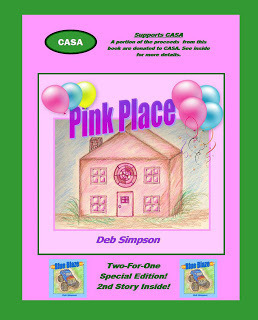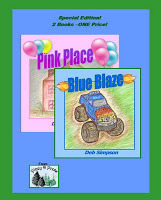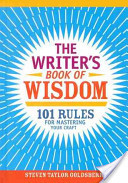Deb Simpson's Blog, page 25
August 26, 2011
Congratulations Goodreads Winners of Pink Place & Blue Blaze, A Special Edition!


Nena Im of Torrance CA, and Lisa Steinmetz of Rochester NY! The books are heading your way! Congratulations and Enjoy!

Published on August 26, 2011 18:41
August 19, 2011
Just the right book title....

When you are trying to come up with that perfect title, remember, keep these points in mind...
see this great little book for more details!
Oxymoronic
Poetic
Cliches
Thematic
Phrases
Classics
Great Tips for Writers

Published on August 19, 2011 15:23
Beta readers-more to know and more to find!
Published on August 19, 2011 13:48
BBeta readers-more to know and more to find!
Published on August 19, 2011 13:48
What is a Beta Reader?
What is a Beta Reader?
What is a beta-reader? Why do authors need them? What makes a good one? These questions I will answer, from both a reader and a writer perspective.
The purpose of a beta reader is to help the author write the best story they can, by pointing out the weaknesses in the story, and telling the author they can do better than that. The latter is aided by leavening the negatives with positive encouragement, and there's two good reasons for that:
to spur on the author to enthusiasm by encouragement. Different authors vary in the amount of positive feedback they need, and different betas vary in the amount they can give.
Pointing out the good bits so that the author doesn't unknowingly remove them!
Beta readers provide another set of eyes to look over a story.
click on the link for more info!

What is a beta-reader? Why do authors need them? What makes a good one? These questions I will answer, from both a reader and a writer perspective.
The purpose of a beta reader is to help the author write the best story they can, by pointing out the weaknesses in the story, and telling the author they can do better than that. The latter is aided by leavening the negatives with positive encouragement, and there's two good reasons for that:
to spur on the author to enthusiasm by encouragement. Different authors vary in the amount of positive feedback they need, and different betas vary in the amount they can give.
Pointing out the good bits so that the author doesn't unknowingly remove them!
Beta readers provide another set of eyes to look over a story.
click on the link for more info!

Published on August 19, 2011 13:47
What is a Beta Reader? m
What is a Beta Reader?
What is a beta-reader? Why do authors need them? What makes a good one? These questions I will answer, from both a reader and a writer perspective.
The purpose of a beta reader is to help the author write the best story they can, by pointing out the weaknesses in the story, and telling the author they can do better than that. The latter is aided by leavening the negatives with positive encouragement, and there's two good reasons for that:
to spur on the author to enthusiasm by encouragement. Different authors vary in the amount of positive feedback they need, and different betas vary in the amount they can give.
Pointing out the good bits so that the author doesn't unknowingly remove them!
Beta readers provide another set of eyes to look over a story.
click on the link for more info!


What is a beta-reader? Why do authors need them? What makes a good one? These questions I will answer, from both a reader and a writer perspective.
The purpose of a beta reader is to help the author write the best story they can, by pointing out the weaknesses in the story, and telling the author they can do better than that. The latter is aided by leavening the negatives with positive encouragement, and there's two good reasons for that:
to spur on the author to enthusiasm by encouragement. Different authors vary in the amount of positive feedback they need, and different betas vary in the amount they can give.
Pointing out the good bits so that the author doesn't unknowingly remove them!
Beta readers provide another set of eyes to look over a story.
click on the link for more info!

Published on August 19, 2011 13:47
More Beta Readers!
Published on August 19, 2011 13:45
Needing Beta Readers??
Published on August 19, 2011 13:43
August 17, 2011
Your Books Bottom Line --Part 3 is now published!
Article by Deb Simpson Your Books Bottom Line Part 3
Formats, Fulfillments, and FeesBy Deb SimpsonThe first two installments of this four part series "Your Book's Bottom Line", focused on book development costs andmarketing costs. In this article, the focus will be on publication costs, including preparing the book for publication, printing, and distribution. Whether you are self-publishing your book, or working with a publishing house, it is still beneficial to understand the elements involved in getting your book into the marketplace. First, a quick review of what may be included:
Formatting: This includes the formatting of the interior pages (margins, spacing, fonts) as well as the sizing, paper and binding.
Editing: This can be done by the author, but use of a professional editor often yields a more professional outcome.
Indexing: Especially necessary for reference books to provide quick subject look-up for readers; may require the services of a professional indexer or purchase of a specific software application.
ISBN#: The International Standard Book Number, required for all books sold commercially via booksellers (Amazon, Barnes & Noble).
UPC#: Universal Product Code, required to sell any product via retail stores or sites (Wal-Mart, etc.).
Book Cover Design: The author may design the cover, but use of a professional designer may be worth the investment. Remember, the cover is the first impression.
Printing Set-up Fees: For offset printing, where plates are created for each book page, there will be set-up fees. For some POD printers, set-up fees may be charged, although less common.
 For the rest of the article, click on the link!
For the rest of the article, click on the link!


Formats, Fulfillments, and FeesBy Deb SimpsonThe first two installments of this four part series "Your Book's Bottom Line", focused on book development costs andmarketing costs. In this article, the focus will be on publication costs, including preparing the book for publication, printing, and distribution. Whether you are self-publishing your book, or working with a publishing house, it is still beneficial to understand the elements involved in getting your book into the marketplace. First, a quick review of what may be included:
Formatting: This includes the formatting of the interior pages (margins, spacing, fonts) as well as the sizing, paper and binding.
Editing: This can be done by the author, but use of a professional editor often yields a more professional outcome.
Indexing: Especially necessary for reference books to provide quick subject look-up for readers; may require the services of a professional indexer or purchase of a specific software application.
ISBN#: The International Standard Book Number, required for all books sold commercially via booksellers (Amazon, Barnes & Noble).
UPC#: Universal Product Code, required to sell any product via retail stores or sites (Wal-Mart, etc.).
Book Cover Design: The author may design the cover, but use of a professional designer may be worth the investment. Remember, the cover is the first impression.
Printing Set-up Fees: For offset printing, where plates are created for each book page, there will be set-up fees. For some POD printers, set-up fees may be charged, although less common.
 For the rest of the article, click on the link!
For the rest of the article, click on the link!
Published on August 17, 2011 16:14
August 16, 2011
Piney D Press: SUBMISSIONS CLOSED
Published on August 16, 2011 18:31



























